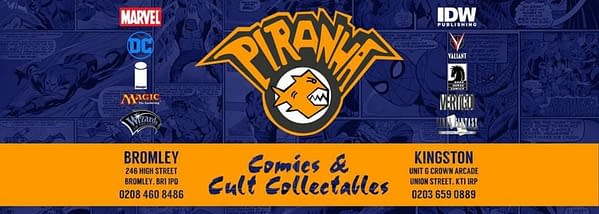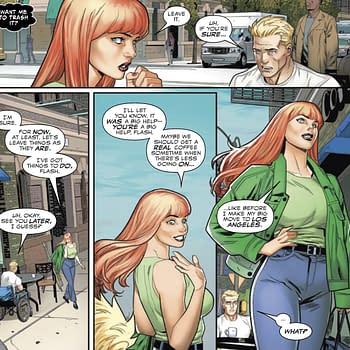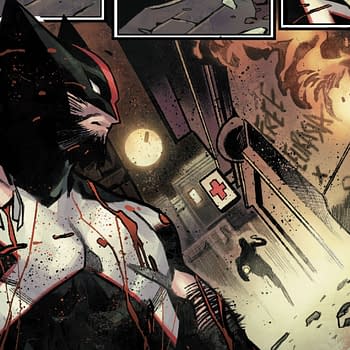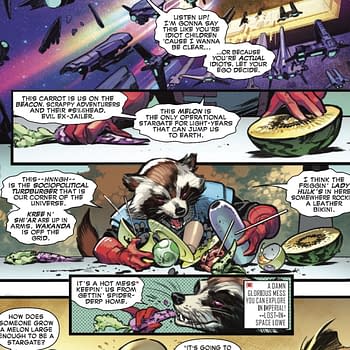Posted in: Comics, Recent Updates | Tagged: nineties, radical
Radical – Why the Nineties Was Actually The Best Decade For Comics
Louis Adcock works for Piranha Comics in both Kingston and Bromley in South London. And he has things to say;
It's no news that the vast majority of comic book readers view the 90s as the worst decade in the history of the medium. With its excesses, terrible costume designs and recycled cynical events written with only the dollar in mind, this view is of course not without merit. Opposing this, a small percentage of fans have made the case that this era was not all bad. With this article, I intend to take this one step further and argue that the 90s were actually the best decade that the industry has ever seen. I know this sound radical, but hear me out…
Headed by Karen Berger and founded in 1993, Vertigo (DC's imprint for mature readers) was responsible for some of the greatest narratives to ever grace the pages of a comic book. Offering a combination of creative freedom and a strong infrastructure which could back and promote any new title that would come out, Vertigo gave us all-time greats such as Garth Ennis' Preacher, Warren Ellis' Transmetropolitan, Grant Morrison's The Invisibles and more. Not to mention the mere existence of this imprint paved the way for other amazing titles in the 2000s such as Brian K. Vaughan's Y the Last Man and Jason Aaron's Scalped to name a couple. Vertigo also provided a home for pre-existing titles such as Neil Gaiman's Sandman and Hellblazer which would grant them independence from the tonally incompatible DC superhero universe. Finally, the importance of Vertigo cannot be overstated when considering the impact that it had on other publishers' attitudes, something that will be explained further down.
Notwithstanding if Vertigo titles can be considered 'indie' (creator-owned is probably the correct term), there were other places to go to see what creators could really do when granted the requisite freedom. The growing popularity of Dark Horse is probably the best example of this. With Frank Miller opting to produce most of his 90s output through Dark Horse (Sin City, Martha Washington, 300, etc.) he proved that Dark Horse could be a vital force in the growing diversity of what was acceptable in the pages of comics. If that were not enough, we also got Hellboy and his universe courtesy of Mike Mignola, John Byrne's Nextmen and other great titles that have stood the test of time. While Dark Horse is probably the most pronounced example for the indie scene outside of Vertigo, David Lapham's Stray Bullets and Terry Moore's Strangers in Paradise also serve as notable examples of what was now possible due to an ever-burgeoning indie scene.
Of course, you can't discuss comics in the 90s without mentioning Image. Ignoring the quality of Image's early output for a second, look at what they do now. As the manager of a comic store myself, the readers that have the most reverence for the medium tend to focus on Image's output these days. I regularly say that my favourite titles coming out today are published by Image, most notably Jeff Lemire's Gideon Falls and W. Maxwell Prince's Ice Cream Man (if you haven't read this, seriously check it out, especially the latest issue, the series is full of genius). The point here is that without that release of Rob Liefeld's Youngblood #1 back in 1992, none of this happens. So, for better or worse, that fan that can't wait for Saga to come back, or is constantly salivating for the next big Image title owes a lot to those 90s Image comics that paved the way for this fertile period of creativity.
It cannot be overstated how much Image changed from the big bucks 90s days to what it is now. After the departure of both Jim Lee and Rob Liefeld, Image lost two universes worth of titles (Wildstorm and Extreme respectively). The then publisher, Jim Valentino, commenced what was dubbed the 'diversity initiative'. This encouraged Image to publish books outside of the superhero norm. Soon after, we began to see titles such as Brian Michael Bendis' Powers, Mark Millar's Wanted, Garth Ennis' The Pro and many more weird and wonderful titles. Personally, I see this as another way of Vertigo's influence permeating the industry as it was the best example to demonstrate to other publisher's that comics do not have to be a one-trick pony.
Finally, regarding Image, people often forget some of the great things that came out of their superhero titles. Firstly, Warren Ellis' Stormwatch is nothing short of top quality. Additionally, Alan Moore released some great work on Spawn, WildC.A.T.S. and other similar titles. But, more simply put than all of this, the art. The entire reason Image was called Image was predicated on the quality of art that would be found in these titles. Not only was this evident from the beginning having some of the best artists that the medium has ever seen in Jim Lee, Marc Silvestri and Todd McFarlane, but the subsequent artists recruited have gone on to make major waves in the industry. Greg Capullo's work on Batman with Scott Snyder defined the character for an era. J. Scott Campbell, without even doing interiors, is still a superstar in the industry. Michael Turner's output before his sad passing was top quality. David Finch is one of the top superhero artists in the modern era, etc. So, Image's influence is still being felt now in mainstream superhero comics in terms of what the expected aesthetic is (I guess it doesn't hurt that Jim Lee is DC's co-publisher).
Proving that this article is not just concerning everything in comics except the big two, this juncture seems like the best time to point out how damn good DC's output was for large parts of this decade. Character defining runs happened during this era, and even that label can't heap enough praise on runs such as Mark Waid's Flash, Chuck Dixon's Nightwing, Grant Morrison's JLA, James Robinson's Starman, I could go on. In a decade that is supposed to be the worst era for comics, that's a hell of a haul of top-quality reads. I also feel compelled to point out that Kingdom Come was released in 1996 and is my personal favourite superhero comic of all time.
Marvel is mainly where the trouble is when combatting the idea that the 90s was a horrid time for comic readers. Even without reading, some of the costume designs alone would be enough to put someone off for life (see the 90s redesigns of Daredevil and Thor in particular). However, desperate as it may seem, it wasn't all bad. Firstly, Mark Waid's Captain America is, in my mind, the best Cap run besides Brubaker's. You also had great runs like Joe Kelly's Deadpool, the X-Men had great moments such as Age of Apocalypse and the Onslaught Saga and the comic book reading populous was introduced to the talent of Alex Ross in the pages of Marvels. So, while the publisher often printed titles not worth the paper they were printed on, there was still quality to be found if you looked hard enough.
But the major case for Marvel is to be made when, in 1998, they handed Joe Quesada and Jimmy Palmiotti control of four titles to be printed under the Marvel Knights imprint. Quickly going back to the influence of Vertigo, this is another instance where Vertigo's influence can be felt. Marvel Knights made the case for the CREATOR coming first. This had not been the case at Marvel and was very much from the Vertigo school of thought which has largely been responsible for the writer, as opposed to be artist, becoming the superstar. Marvel Knights very much followed that model. For this imprint, Marvel managed to grab Kevin Smith for Daredevil (who had an insane amount of popularity and credibility at the time), Paul Jenkins for Inhumans, Christopher Priest for Black Panther and, later on, even Garth Ennis for Punisher. So, once again, despite a wave of terrible material, Marvel managed to turn the tide and set the standard for its ascendancy during the 90s.
Given all of the above, I guess the point I'm making is that the 90s was an amazing time for comics if you looked in the right place. I like to think I've made that abundantly clear by pointing out all of the amazing work that was produced during this time. Moreover, game-changing shakeups that occurred during the 90s have been responsible for a lot of the quality stuff that we read now (the forming of Image, Vertigo, Marvel Knights, etc.) So, after that, are you convinced? Probably not, but I thought this would be a fun piece of writing on my personal favourite era for the comic book medium.












